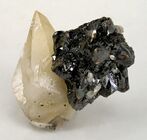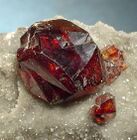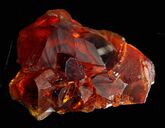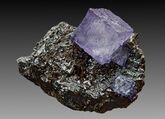Chemistry:Sphalerite
| Sphalerite | |
|---|---|
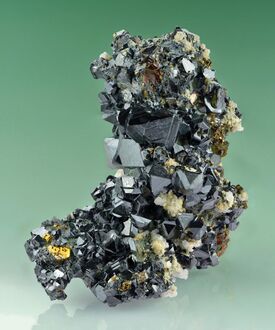 Black crystals of sphalerite with minor chalcopyrite and calcite | |
| General | |
| Category | Sulfide mineral |
| Formula (repeating unit) | (Zn,Fe)S |
| Strunz classification | 2.CB.05a |
| Dana classification | 02.08.02.01 |
| Crystal system | Cubic |
| Crystal class | Hextetrahedral (43m) H-M symbol: (4 3m) |
| Space group | F43m (No. 216) |
| Unit cell | a = 5.406 Å; Z = 4 |
| Structure | |
| Jmol (3D) | Interactive image |
| Identification | |
| Color | Light to dark brown, red-brown, yellow, red, green, light blue, black and colourless. |
| Crystal habit | Euhedral crystals – occurs as well-formed crystals showing good external form. Granular – generally occurs as anhedral to subhedral crystals in matrix. |
| Twinning | Simple contact twins or complex lamellar forms, twin axis [111] |
| Cleavage | perfect dodecahedral on [011] |
| Fracture | Uneven to conchoidal |
| Mohs scale hardness | 3.5–4 |
| |re|er}} | Adamantine, resinous, greasy |
| Streak | brownish white, pale yellow |
| Diaphaneity | Transparent to translucent, opaque when iron-rich |
| Specific gravity | 3.9–4.2 |
| Optical properties | Isotropic |
| Refractive index | nα = 2.369 |
| Other characteristics | non-radioactive, non-magnetic, fluorescent and triboluminescent. |
| References | [1][2][3] |
Sphalerite (sometimes spelled sphaelerite) is a sulfide mineral with the chemical formula (Zn,Fe)S.[5] It is the most important ore of zinc. Sphalerite is found in a variety of deposit types, but it is primarily in sedimentary exhalative, Mississippi-Valley type, and volcanogenic massive sulfide deposits. It is found in association with galena, chalcopyrite, pyrite (and other sulfides), calcite, dolomite, quartz, rhodochrosite, and fluorite.[6]
German geologist Ernst Friedrich Glocker discovered sphalerite in 1847, naming it based on the Greek word sphaleros, meaning "deceiving", due to the difficulty of identifying the mineral.[7]
In addition to zinc, sphalerite is an ore of cadmium, gallium, germanium, and indium. Miners have been known to refer to sphalerite as zinc blende, black-jack, and ruby blende.[8] Marmatite is an opaque black variety with a high iron content.[9]
Crystal habit and structure
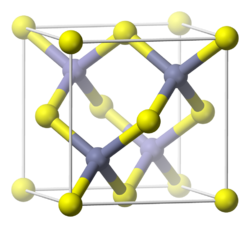
Sphalerite crystallizes in the face-centered cubic zincblende crystal structure,[10] which named after the mineral. This structure is a member of the hextetrahedral crystal class (space group F43m). In the crystal structure, both the sulfur and the zinc or iron ions occupy the points of a face-centered cubic lattice, with the two lattices displaced from each other such that the zinc and iron are tetrahedrally coordinated to the sulfur ions, and vice versa.[11] Minerals similar to sphalerite include those in the sphalerite group, consisting of sphalerite, colaradoite, hawleyite, metacinnabar, stilleite and tiemannite.[12] The structure is closely related to the structure of diamond.[10] The hexagonal polymorph of sphalerite is wurtzite, and the trigonal polymorph is matraite.[12] Wurtzite is the higher temperature polymorph, stable at temperatures above 1,020 °C (1,870 °F).[13] The lattice constant for zinc sulfide in the zinc blende crystal structure is 0.541 nm.[14] Sphalerite has been found as a pseudomorph, taking the crystal structure of galena, tetrahedrite, barite and calcite.[13][15] Sphalerite can have Spinel Law twins, where the twin axis is [111].
The chemical formula of sphalerite is (Zn,Fe)S; the iron content generally increases with increasing formation temperature and can reach up to 40%.[6] The material can be considered a ternary compound between the binary endpoints ZnS and FeS with composition ZnxFe(x-1)S, where x can range from 1 (pure ZnS) to 0.6.
All natural sphalerite contains concentrations of various impurities, which generally substitute for zinc in the cation position in the lattice; the most common cation impurities are cadmium, mercury and manganese, but gallium, germanium and indium may also be present in relatively high concentrations (hundreds to thousands of ppm).[16][17] Cadmium can replace up to 1% of zinc and manganese is generally found in sphalerite with high iron abundances.[12] Sulfur in the anion position can be substituted for by selenium and tellurium.[12] The abundances of these impurities are controlled by the conditions under which the sphalerite formed; formation temperature, pressure, element availability and fluid composition are important controls.[17]
Properties
Physical properties
Sphalerite possesses perfect dodecahedral cleavage, having six cleavage planes.[10][18] In pure form, it is a semiconductor, but transitions to a conductor as the iron content increases.[19] It has a hardness of 3.5 to 4 on the Mohs scale of mineral hardness.[20]
It can be distinguished from similar minerals by its perfect cleavage, its distinctive resinous luster, and the reddish-brown streak of the darker varieties.[21]
Optical properties

Pure zinc sulfide is a wide-bandgap semiconductor, with bandgap of about 3.54 electron volts, which makes the pure material transparent in the visible spectrum. Increasing iron content will make the material opaque, while various impurities can give the crystal a variety of colors.[20] In thin section, sphalerite exhibits very high positive relief and appears colorless to pale yellow or brown, with no pleochroism.[6]
The refractive index of sphalerite (as measured via sodium light, average wavelength 589.3 nm) ranges from 2.37 when it is pure ZnS to 2.50 when there is 40% iron content.[6] Sphalerite is isotropic under cross-polarized light, however sphalerite can experience birefringence if intergrown with its polymorph wurtzite; the birefringence can increase from 0 (0% wurtzite) up to 0.022 (100% wurtzite).[6][13]
Depending on the impurities, sphalerite will fluoresce under ultraviolet light. Sphalerite can be triboluminescent.[22] Sphalerite has a characteristic triboluminescence of yellow-orange. Typically, specimens cut into end-slabs are ideal for displaying this property.
Varieties
Gemmy, colorless to pale green sphalerite from Franklin, New Jersey (see Franklin Furnace), are highly fluorescent orange and/or blue under longwave ultraviolet light and are known as cleiophane, an almost pure ZnS variety.[23] Cleiophane contains less than 0.1% of iron in the sphalerite crystal structure.[12] Marmatite or christophite is an opaque black variety of sphalerite and its coloring is due to high quantities of iron, which can reach up to 25%; marmatite is named after Marmato mining district in Colombia and christophite is named for the St. Christoph mine in Breitenbrunn, Saxony.[23] Both marmatite and cleiophane are not recognized by the International Mineralogical Association (IMA).[24] Red, orange or brownish-red sphalerite is termed ruby blende or ruby zinc, whereas dark colored sphalerite is termed black-jack.[23]
Deposit types
Sphalerite is amongst the most common sulfide minerals, and it is found worldwide and in a variety of deposit types.[8] The reason for the wide distribution of sphalerite is that it appears in many types of deposits; it is found in skarns,[25] hydrothermal deposits,[26] sedimentary beds,[27] volcanogenic massive sulfide deposits (VMS),[28] Mississippi-valley type deposits (MVT),[29][30] granite[12] and coal.[31]
Sedimentary exhalitive
Approximately 50% of zinc (from sphalerite) and lead comes from Sedimentary exhalative (SEDEX) deposits, which are stratiform Pb-Zn sulfides that form at seafloor vents.[32] The metals precipitate from hydrothermal fluids and are hosted by shales, carbonates and organic-rich siltstones in back-arc basins and failed continental rifts.[33] The main ore minerals in SEDEX deposits are sphalerite, galena, pyrite, pyrrhotite and marcasite, with minor sulfosalts such as tetrahedrite-freibergite and boulangerite; the zinc + lead grade typically ranges between 10 and 20%.[33] Important SEDEX mines are Red Dog in Alaska, Sullivan Mine in British Columbia, Mount Isa and Broken Hill in Australia and Mehdiabad in Iran.[34]
Mississippi-Valley type
Similar to SEDEX, Mississippi-Valley type (MVT) deposits are also a Pb-Zn deposit which contains sphalerite.[35] However, they only account for 15–20% of zinc and lead, are 25% smaller in tonnage than SEDEX deposits and have lower grades of 5–10% Pb + Zn.[33] MVT deposits form from the replacement of carbonate host rocks such as dolostone and limestone by ore minerals; they are located in platforms and foreland thrust belts.[33] Furthermore, they are stratabound, typically Phanerozoic in age and epigenetic (form after the lithification of the carbonate host rocks).[36] The ore minerals are the same as SEDEX deposits: sphalerite, galena, pyrite, pyrrhotite and marcasite, with minor sulfosalts.[36] Mines that contain MVT deposits include Polaris in the Canadian arctic, Mississippi River in the United States , Pine Point in Northwest Territories, and Admiral Bay in Australia.[37]
Volcanogenic massive sulfide
Volcanogenic massive sulfide (VMS) deposits can be Cu-Zn- or Zn-Pb-Cu-rich, and accounts for 25% of Zn in reserves.[33] There are various types of VMS deposits with a range of regional contexts and host rock compositions; a common characteristic is that they are all hosted by submarine volcanic rocks.[32] They form from metals such as copper and zinc being transferred by hydrothermal fluids (modified seawater) which leach them from volcanic rocks in the oceanic crust; the metal-saturated fluid rises through fractures and faults to the surface, where it cools and deposits the metals as a VMS deposit.[38] The most abundant ore minerals are pyrite, chalcopyrite, sphalerite and pyrrhotite.[33] Mines that contain VMS deposits include Kidd Creek in Ontario, Urals in Russia , Troodos in Cyprus and Besshi in Japan .[39]
Localities
The top producers of sphalerite include the United States, Russia, Mexico, Germany , Australia, Canada , China , Ireland, Peru, Kazakhstan and England .[40][41]
Sources of high quality crystals include:
| Place | Country |
|---|---|
| Freiberg, Saxony, Neudorf, Harz Mountains |
Germany |
| Lengenbach Quarry, Binntal, Valais | Switzerland |
| Horní Slavkov and Příbram | Czech Republic |
| Rodna | Romania |
| Madan, Smolyan Province, Rhodope Mountains | Bulgaria |
| Aliva mine, Picos de Europa Mountains, Cantabria [Santander] Province | Spain |
| Alston Moor, Cumbria | England |
| Dalnegorsk, Primorskiy Kray | Russia |
| Watson Lake, Yukon Territory | Canada |
| Flin Flon, Manitoba | Canada |
| Tri-State district including deposits near Baxter Springs, Cherokee County, Kansas; Joplin, Jasper County, Missouri and Picher, Ottawa County, Oklahoma |
USA |
| Elmwood mine, near Carthage, Smith County, Tennessee | USA |
| Eagle mine, Gilman district, Eagle County, Colorado | USA |
| Santa Eulalia, Chihuahua | Mexico |
| Naica, Chihuahua | Mexico |
| Cananea, Sonora | Mexico |
| Huaron | Peru |
| Casapalca | Peru |
| Huancavelica | Peru |
| Zinkgruvan | Sweden |
Uses
Metal ore
Sphalerite is an important ore of zinc; around 95% of all primary zinc is extracted from sphalerite ore.[42] However, due to its variable trace element content, sphalerite is also an important source of several other metals such as cadmium,[43] gallium,[44] germanium,[45] and indium[46] which replace zinc. The ore was originally called blende by miners (from German blind or deceiving) because it resembles galena but yields no lead.[21]
Brass and bronze
The zinc in sphalerite is used to produce brass, an alloy of copper with 3–45% zinc.[18] Major element alloy compositions of brass objects provide evidence that sphalerite was being used to produce brass by the Islamic as far back as the medieval ages between the 7th and 16th century CE.[47] Sphalerite may have also been used during the cementation process of brass in Northern China during the 12th–13th century CE (Jin Dynasty).[48] Similarly to brass, the zinc in sphalerite can also be used to produce certain types of bronze; bronze is dominantly copper which is alloyed with other metals such as tin, zinc, lead, nickel, iron and arsenic.[49]
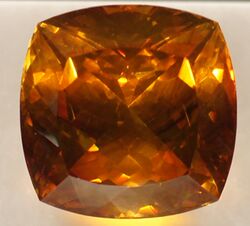
Other
- Yule Marble – sphalerite is found as intrusions in yule marble, which is used as a building material for the Lincoln Memorial and Tomb of the Unknown.[50]
- Galvanized iron – zinc from sphalerite is used as a protective coating to prevent corrosion and rusting; it is used on power transmission towers, nails and automobiles.[41]
- Batteries.[51]
- Gemstone.[52][53]The largest and best quality sphalerite gems come from the Aliva mine, Cantabria, Spain.
Gallery
-
Sphalerite and barite from Cumberland Mine, Tennessee, USA
-
Sphalerite on dolostone, from Millersville Quarry, Ohio, USA
-
Tan crystal of calcite attached to a cluster of black sphalerite crystals
-
Sharp, tetrahedral sphalerite crystals with minor associated chalcopyrite from the Idarado Mine, Telluride, Ouray District, Colorado, USA
-
Gem quality twinned cherry-red sphalerite crystal (1.8 cm) from Hunan Province, China
-
Sphalerite crystals from Áliva, Camaleño, Cantabria (Spain)
-
Purple fluorite and sphalerite, from the Elmwood mine, Smith county, Tennessee, US
-
Sphalerite crystal in geodized brachiopod
See also
References
- ↑ Sphalerite, WebMineral.com, http://webmineral.com/data/Sphalerite.shtml
- ↑ Sphalerite, MinDat.org, http://www.mindat.org/show.php?id=3727
- ↑ Anthony, John W.; Bideaux, Richard A.; Bladh, Kenneth W.; Nichols, Monte C. (2005). "Sphalerite". Mineral Data Publishing. http://www.handbookofmineralogy.org/pdfs/sphalerite.pdf.
- ↑ Warr, L.N. (2021). "IMA–CNMNC approved mineral symbols". Mineralogical Magazine 85 (3): 291–320. doi:10.1180/mgm.2021.43. Bibcode: 2021MinM...85..291W.
- ↑ Muntyan, Barbara L. (1999). "Colorado Sphalerite" (in en). Rocks & Minerals 74 (4): 220–235. doi:10.1080/00357529909602545. ISSN 0035-7529. Bibcode: 1999RoMin..74..220M. http://www.tandfonline.com/doi/abs/10.1080/00357529909602545.
- ↑ 6.0 6.1 6.2 6.3 6.4 Nesse, William D. (2013). Introduction to optical mineralogy (4th ed.). New York: Oxford University Press. pp. 121. ISBN 978-0-19-984627-6. OCLC 817795500. https://www.worldcat.org/oclc/817795500.
- ↑ Glocker, Ernst Friedrich. Generum et specierum mineralium, secundum ordines naturales digestorum synopsis, omnium, quotquot adhuc reperta sunt mineralium nomina complectens. : Adjectis synonymis et veteribus et recentioribus ac novissimarum analysium chemicarum summis. Systematis mineralium naturalis prodromus.. OCLC 995480390. http://worldcat.org/oclc/995480390.
- ↑ 8.0 8.1 Richard Rennie and Jonathan Law (2016). A dictionary of chemistry (7th ed.). Oxford: Oxford University Press. ISBN 978-0-19-178954-0. OCLC 936373100. https://www.worldcat.org/oclc/936373100.
- ↑ Zhou, Jiahui; Jiang, Feng; Li, Sijie; Zhao, Wenqing; Sun, Wei; Ji, Xiaobo; Yang, Yue (2019). "Natural marmatite with low discharge platform and excellent cyclicity as potential anode material for lithium-ion batteries" (in en). Electrochimica Acta 321: 134676. doi:10.1016/j.electacta.2019.134676. https://linkinghub.elsevier.com/retrieve/pii/S0013468619315476.
- ↑ 10.0 10.1 10.2 Klein, Cornelis (2017). Earth materials: introduction to mineralogy and petrology. Anthony R. Philpotts (2nd ed.). Cambridge, United Kingdom. ISBN 978-1-107-15540-4. OCLC 962853030. https://www.worldcat.org/oclc/962853030.
- ↑ Klein, Cornelis; Hurlbut, Cornelius S. Jr. (1993). Manual of mineralogy : (after James D. Dana) (21st ed.). New York: Wiley. pp. 211–212. ISBN 047157452X.
- ↑ 12.0 12.1 12.2 12.3 12.4 12.5 Cook, Robert B. (2003). "Connoisseur's Choice: Sphalerite, Eagle Mine, Gilman, Eagle County, Colorado" (in en). Rocks & Minerals 78 (5): 330–334. doi:10.1080/00357529.2003.9926742. ISSN 0035-7529. Bibcode: 2003RoMin..78..330C. http://www.tandfonline.com/doi/abs/10.1080/00357529.2003.9926742.
- ↑ 13.0 13.1 13.2 Deer, W. A. (2013). An introduction to the rock-forming minerals. R. A. Howie, J. Zussman (3rd ed.). London. ISBN 978-0-903056-27-4. OCLC 858884283. https://www.worldcat.org/oclc/858884283.
- ↑ International Centre for Diffraction Data reference 04-004-3804, ICCD reference 04-004-3804.
- ↑ Kloprogge, J. Theo (2017). Photo atlas of mineral pseudomorphism. Robert M. Lavinsky. Amsterdam, Netherlands. ISBN 978-0-12-803703-4. OCLC 999727666. https://www.worldcat.org/oclc/999727666.
- ↑ Cook, Nigel J.; Ciobanu, Cristiana L.; Pring, Allan; Skinner, William; Shimizu, Masaaki; Danyushevsky, Leonid; Saini-Eidukat, Bernhardt; Melcher, Frank (2009). "Trace and minor elements in sphalerite: A LA-ICPMS study" (in en). Geochimica et Cosmochimica Acta 73 (16): 4761–4791. doi:10.1016/j.gca.2009.05.045. Bibcode: 2009GeCoA..73.4761C. https://linkinghub.elsevier.com/retrieve/pii/S0016703709003263.
- ↑ 17.0 17.1 Frenzel, Max; Hirsch, Tamino; Gutzmer, Jens (July 2016). "Gallium, germanium, indium, and other trace and minor elements in sphalerite as a function of deposit type — A meta-analysis". Ore Geology Reviews 76: 52–78. doi:10.1016/j.oregeorev.2015.12.017. Bibcode: 2016OGRv...76...52F.
- ↑ 18.0 18.1 Klein, Cornelis; Philpotts, Anthony (2017). Earth materials : introduction to mineralogy and petrology (2nd ed.). Cambridge: Cambridge University Press. ISBN 978-1-107-15540-4. OCLC 975051556. https://www.worldcat.org/oclc/975051556.
- ↑ Deng, Jiushuai; Lai, Hao; Chen, Miao; Glen, Matthew; Wen, Shuming; Zhao, Biao; Liu, Zilong; Yang, Hua et al. (June 2019). "Effect of iron concentration on the crystallization and electronic structure of sphalerite/marmatite: A DFT study". Minerals Engineering 136: 168–174. doi:10.1016/j.mineng.2019.02.012. Bibcode: 2019MiEng.136..168D.
- ↑ 20.0 20.1 Hobart M. King, Sphalerite, geology.com. Retrieved 22 Feb. 2022.
- ↑ 21.0 21.1 Klein & Hurlbut 1993, p. 357.
- ↑ "Sphalerite". 2005. https://www.handbookofmineralogy.org/pdfs/sphalerite.pdf.
- ↑ 23.0 23.1 23.2 Manutchehr-Danai, Mohsen (2009). Dictionary of gems and gemology (3rd ed.). New York: Springer-Verlag, Berlin, Heidelberg. ISBN 9783540727958. OCLC 646793373. https://www.worldcat.org/oclc/646793373.
- ↑ "International Mineralogical Association - Commission on New Minerals, Nomenclature and Classification". http://cnmnc.main.jp/.
- ↑ Ye, Lin; Cook, Nigel J.; Ciobanu, Cristiana L.; Yuping, Liu; Qian, Zhang; Tiegeng, Liu; Wei, Gao; Yulong, Yang et al. (2011). "Trace and minor elements in sphalerite from base metal deposits in South China: A LA-ICPMS study" (in en). Ore Geology Reviews 39 (4): 188–217. doi:10.1016/j.oregeorev.2011.03.001. Bibcode: 2011OGRv...39..188Y. https://linkinghub.elsevier.com/retrieve/pii/S0169136811000217.
- ↑ Knorsch, Manuel; Nadoll, Patrick; Klemd, Reiner (2020). "Trace elements and textures of hydrothermal sphalerite and pyrite in Upper Permian (Zechstein) carbonates of the North German Basin" (in en). Journal of Geochemical Exploration 209: 106416. doi:10.1016/j.gexplo.2019.106416. Bibcode: 2020JCExp.20906416K. https://linkinghub.elsevier.com/retrieve/pii/S0375674218306708.
- ↑ Zhu, Chuanwei; Liao, Shili; Wang, Wei; Zhang, Yuxu; Yang, Tao; Fan, Haifeng; Wen, Hanjie (2018). "Variations in Zn and S isotope chemistry of sedimentary sphalerite, Wusihe Zn-Pb deposit, Sichuan Province, China" (in en). Ore Geology Reviews 95: 639–648. doi:10.1016/j.oregeorev.2018.03.018. Bibcode: 2018OGRv...95..639Z. https://linkinghub.elsevier.com/retrieve/pii/S0169136817306224.
- ↑ Akbulut, Mehmet; Oyman, Tolga; Çiçek, Mustafa; Selby, David; Özgenç, İsmet; Tokçaer, Murat (2016). "Petrography, mineral chemistry, fluid inclusion microthermometry and Re–Os geochronology of the Küre volcanogenic massive sulfide deposit (Central Pontides, Northern Turkey)" (in en). Ore Geology Reviews 76: 1–18. doi:10.1016/j.oregeorev.2016.01.002. Bibcode: 2016OGRv...76....1A. https://linkinghub.elsevier.com/retrieve/pii/S016913681630004X.
- ↑ Nakai, Shun'ichi; Halliday, Alex N; Kesler, Stephen E; Jones, Henry D; Kyle, J.Richard; Lane, Thomas E (1993). "Rb-Sr dating of sphalerites from Mississippi Valley-type (MVT) ore deposits" (in en). Geochimica et Cosmochimica Acta 57 (2): 417–427. doi:10.1016/0016-7037(93)90440-8. Bibcode: 1993GeCoA..57..417N. https://linkinghub.elsevier.com/retrieve/pii/0016703793904408.
- ↑ Viets, John G.; Hopkins, Roy T.; Miller, Bruce M. (1992). "Variations in minor and trace metals in sphalerite from mississippi valley-type deposits of the Ozark region; genetic implications" (in en). Economic Geology 87 (7): 1897–1905. doi:10.2113/gsecongeo.87.7.1897. ISSN 1554-0774. Bibcode: 1992EcGeo..87.1897V. http://pubs.geoscienceworld.org/economicgeology/article/87/7/1897/21105/Variations-in-minor-and-trace-metals-in-sphalerite.
- ↑ Hatch, J. R.; Gluskoter, H. J.; Lindahl, P. C. (1976). "Sphalerite in coals from the Illinois Basin" (in en). Economic Geology 71 (3): 613–624. doi:10.2113/gsecongeo.71.3.613. ISSN 1554-0774. Bibcode: 1976EcGeo..71..613H. http://pubs.geoscienceworld.org/economicgeology/article/71/3/613/18771/Sphalerite-in-coals-from-the-Illinois-Basin.
- ↑ 32.0 32.1 Kropschot, S.J.; Doebrich, Jeff L. (2011). "Zinc-The key to preventing corrosion". Fact Sheet. doi:10.3133/fs20113016. ISSN 2327-6932.
- ↑ 33.0 33.1 33.2 33.3 33.4 33.5 Arndt, N. T. (2015). Metals and society : an introduction to economic geology. Stephen E. Kesler, Clément Ganino (2nd ed.). Cham. ISBN 978-3-319-17232-3. OCLC 914168910. https://www.worldcat.org/oclc/914168910.
- ↑ Emsbo, Poul; Seal, Robert R.; Breit, George N.; Diehl, Sharon F.; Shah, Anjana K. (2016). "Sedimentary exhalative (SEDEX) zinc-lead-silver deposit model". Scientific Investigations Report. doi:10.3133/sir20105070n. ISSN 2328-0328.
- ↑ Misra, Kula C. (2000), "Mississippi Valley-Type (MVT) Zinc-Lead Deposits", Understanding Mineral Deposits (Dordrecht: Springer Netherlands): pp. 573–612, doi:10.1007/978-94-011-3925-0_13, ISBN 978-94-010-5752-3, http://dx.doi.org/10.1007/978-94-011-3925-0_13, retrieved 2021-03-26
- ↑ 36.0 36.1 Haldar, S.K. (2020), "Mineral deposits: host rocks and genetic model", Introduction to Mineralogy and Petrology (Elsevier): pp. 313–348, doi:10.1016/b978-0-12-820585-3.00009-0, ISBN 978-0-12-820585-3, http://dx.doi.org/10.1016/b978-0-12-820585-3.00009-0, retrieved 2021-03-26
- ↑ Sangster, D F (1995). Mississippi valley-type lead-zinc. doi:10.4095/207988.
- ↑ Roland., Shanks, Wayne C. Thurston (2012). Volcanogenic massive sulfide occurrence model. U.S. Dept. of the Interior, U.S. Geological Survey. OCLC 809680409. http://worldcat.org/oclc/809680409.
- ↑ du Bray, Edward A. (1995). "Preliminary compilation of descriptive geoenvironmental mineral deposit models". Open-File Report. doi:10.3133/ofr95831. ISSN 2331-1258.
- ↑ Muntyan, Barbara L. (1999). "Colorado Sphalerite" (in en). Rocks & Minerals 74 (4): 220–235. doi:10.1080/00357529909602545. ISSN 0035-7529. Bibcode: 1999RoMin..74..220M. http://www.tandfonline.com/doi/abs/10.1080/00357529909602545.
- ↑ 41.0 41.1 "Zinc" (in en). Agricultural and Mineral Commodities Year Book (0 ed.). Routledge. 2003-09-02. pp. 358–366. doi:10.4324/9780203403556-47. ISBN 978-0-203-40355-6. https://www.taylorfrancis.com/books/9781135356118/chapters/10.4324/9780203403556-47. Retrieved 2021-02-25.
- ↑ "Zinc Statistics and Information". https://www.usgs.gov/centers/nmic/zinc-statistics-and-information.
- ↑ Cadmium - In: USGS Mineral Commodity Summaries. United States Geological Survey. 2017. https://minerals.usgs.gov/minerals/pubs/commodity/cadmium/.
- ↑ Frenzel, Max; Ketris, Marina P.; Seifert, Thomas; Gutzmer, Jens (March 2016). "On the current and future availability of gallium". Resources Policy 47: 38–50. doi:10.1016/j.resourpol.2015.11.005. Bibcode: 2016RePol..47...38F.
- ↑ Frenzel, Max; Ketris, Marina P.; Gutzmer, Jens (2014-04-01). "On the geological availability of germanium" (in en). Mineralium Deposita 49 (4): 471–486. doi:10.1007/s00126-013-0506-z. ISSN 0026-4598. Bibcode: 2014MinDe..49..471F.
- ↑ Frenzel, Max; Mikolajczak, Claire; Reuter, Markus A.; Gutzmer, Jens (June 2017). "Quantifying the relative availability of high-tech by-product metals – The cases of gallium, germanium and indium". Resources Policy 52: 327–335. doi:10.1016/j.resourpol.2017.04.008. Bibcode: 2017RePol..52..327F.
- ↑ Craddock, P.T. (1990). Brass in the medieval Islamic world; 2000 years of zinc and brass. British Museum Publications Ltd.. pp. 73–101. ISBN 0-86159-050-3.
- ↑ Xiao, Hongyan; Huang, Xin; Cui, Jianfeng (2020). "Local cementation brass production during 12th–13th century CE, North China: Evidences from a royal summer palace of Jin Dynasty" (in en). Journal of Archaeological Science: Reports 34: 102657. doi:10.1016/j.jasrep.2020.102657. Bibcode: 2020JArSR..34j2657X. https://linkinghub.elsevier.com/retrieve/pii/S2352409X2030448X.
- ↑ Tylecote, R. F. (2002). A history of metallurgy. Institute of Materials (2nd ed.). London: Maney Pub., for the Institute of Materials. ISBN 1-902653-79-3. OCLC 705004248. https://www.worldcat.org/oclc/705004248.
- ↑ S., McGee, E. (1999). Colorado Yule marble : building stone of the Lincoln Memorial : an investigation of differences in durability of the Colorado Yule marble, a widely used building stone. U.S. Dept. of the Interior, U.S. Geological Survey. ISBN 0-607-91994-9. OCLC 1004947563. http://worldcat.org/oclc/1004947563.
- ↑ Hai, Yun; Wang, Shuonan; Liu, Hao; Lv, Guocheng; Mei, Lefu; Liao, Libing (2020). "Nanosized Zinc Sulfide/Reduced Graphene Oxide Composite Synthesized from Natural Bulk Sphalerite as Good Performance Anode for Lithium-Ion Batteries" (in en). JOM 72 (12): 4505–4513. doi:10.1007/s11837-020-04372-5. ISSN 1047-4838. Bibcode: 2020JOM....72.4505H. http://link.springer.com/10.1007/s11837-020-04372-5.
- ↑ Voudouris, Panagiotis; Mavrogonatos, Constantinos; Graham, Ian; Giuliani, Gaston; Tarantola, Alexandre; Melfos, Vasilios; Karampelas, Stefanos; Katerinopoulos, Athanasios et al. (2019-07-29). "Gemstones of Greece: Geology and Crystallizing Environments" (in en). Minerals 9 (8): 461. doi:10.3390/min9080461. ISSN 2075-163X. Bibcode: 2019Mine....9..461V.
- ↑ Murphy, Jack; Modreski, Peter (2002-08-01). "A Tour of Colorado Gemstone Localities" (in en). Rocks & Minerals 77 (4): 218–238. doi:10.1080/00357529.2002.9925639. ISSN 0035-7529. Bibcode: 2002RoMin..77..218M. http://www.tandfonline.com/doi/abs/10.1080/00357529.2002.9925639.
Further reading
- Dana's Manual of Mineralogy ISBN:0-471-03288-3
- Webster, R., Read, P. G. (Ed.) (2000). Gems: Their sources, descriptions and identification (5th ed.), p. 386. Butterworth-Heinemann, Great Britain. ISBN:0-7506-1674-1
External links
- The sphalerite structure
- Possible relation of Sphalerite to origins of life and precursor chemicals in 'Primordial Soup'
- Minerals.net
- Minerals of Franklin, NJ
{{Navbox |name = Ores |title = Ore minerals, mineral mixtures and ore deposits |listclass = hlist
|group1 = Ores |list1 =
{{Navbox|subgroup
|groupwidth = 7.0em
|group1 = Oxides |list1 =
- Cassiterite (tin)
- Chromite (chromium)
- Coltan (niobium and tantalum)
- Columbite (niobium)
- Hematite (iron)
- Ilmenite (titanium)
- Magnetite (iron)}}
- Pyrolusite (manganese)
- Tantalite (tantalum)
- Uraninite (uranium)
 |


